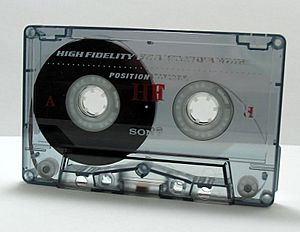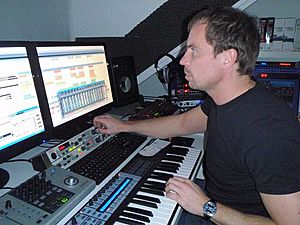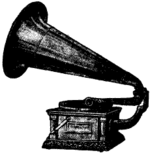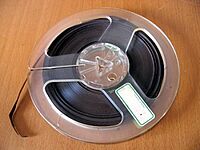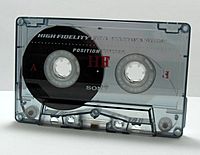History of sound recording facts for kids
The history of sound recording is like a journey through time, showing how we learned to capture and play back sounds. This journey has seen many amazing inventions and new technologies. We can split this history into four main periods:
- The Acoustic Era (1877–1925)
- The Electrical Era (1925–1945)
- The Magnetic Era (1945–1975)
- The Digital Era (1975–present)
People started trying to record sound in the 1800s, during the Industrial Revolution. Many early attempts were made in the late 1800s. A key invention was Édouard-Léon Scott de Martinville's phonautograph in 1857. These efforts led to Thomas Edison inventing the phonograph in 1877. Later, in the late 20th century, digital recording arrived. It has grown very popular with digital music and online streaming.
Contents
- Capturing Sound: A Journey Through Time
- Acoustical Recording: How It Worked
- Electrical Recording: Better Sound Quality
- Magnetic Recording: The Tape Revolution
- Recording on Film: Movies Get Sound
- Digital Recording: The Modern Age
- The Revival of Vinyl: Old is New Again
- Recording Techniques: How It's Done
- See also
Capturing Sound: A Journey Through Time
The Acoustic Era (1877–1925): Early Mechanical Recordings
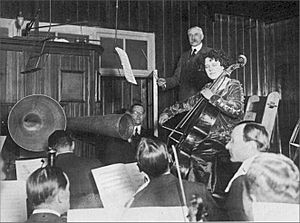
The first ways to record sound were purely mechanical. These early recorders used a big horn to collect sound waves. A thin sheet, called a diaphragm, was at the end of the horn. This diaphragm was connected to a sharp needle, or stylus. As sound waves made the diaphragm move, the stylus scratched the sound waves onto a moving surface. This surface could be coated paper, a cylinder, or a disc covered in wax or soft metal.
These early recordings did not sound very clear and were not very loud. They could only capture a small part of the sounds we hear. Musicians and engineers had to change how they played and recorded. Bands often used louder instruments like trumpets and trombones. Lower brass instruments like the tuba often replaced the double bass. Performers also had to stand in specific spots around the horn to make the sound balanced. They had to play as loudly as possible. Home phonographs also had limited sound quality and volume.
By the end of this era, the disc became the main way to record sound. Discs stayed popular for home audio until the late 20th century.
The Electrical Era (1925–1945): New Ways to Record Sound
The next big step in sound recording came in 1925. Western Electric introduced a new system. It used electrical microphones, electronic amplifiers, and electromechanical recorders. Major US record companies quickly adopted this system. Recording sound now became a mix of old and new methods. Sound could be captured, made louder, and balanced using electronics. The machine that cut the sound onto the disc was now electric. But the actual recording still involved physically carving the sound into a wax disc. Consumer discs were then made by stamping metal copies of the wax master. These were first made from a shellac mix, then later from polyvinyl plastic.
The Western Electric system greatly improved sound quality. It could record a much wider range of sounds, from 60 Hz to 6000 Hz. This allowed sound engineers to capture richer and more detailed sound. They used many microphones connected to electronic mixers. Electrical microphones changed how singers performed, leading to the rise of "crooners." Electronic amplification also helped create broadcast radio and public address systems. It also led to amplified home record players.
New electronic instruments also appeared, like the Theremin and the Novachord. These allowed musicians to create entirely new sounds.
Sound in Movies: A Big Leap
Around the same time, inventors worked to add synchronized sound to films. Some early sound films, like The Jazz Singer (1927), used large soundtrack records. These records played on a turntable linked to the movie projector. By the early 1930s, most movies used sound-on-film technology. Here, the audio signal was turned into light. This light was then photographed onto the film as a soundtrack. Projectors would then convert this light back into sound.
Sound-on-film helped movie engineers develop multi-tracking. This meant they could record different sounds (voices, effects, music) separately. Then, they could mix them together and sync them with the movie. This created complex soundscapes. A famous example is the "Tarzan yell," which was created by combining different sounds.
One important device from this era is the loudspeaker. It was invented in the 1920s and has stayed mostly the same. A loudspeaker turns electrical signals back into sound waves. It usually has a cone that moves back and forth when an electrical signal is sent to it. This movement creates the sound we hear. Even with many new technologies, the dynamic loudspeaker is still the most common way to play back sound.
The Magnetic Era (1945–1975): Tape Changes Everything
The third big change in audio recording began in 1945. The Allied nations learned about a new German invention: magnetic tape recording. This technology was invented in the 1930s but was kept secret in Germany during World War II. Magnetic tape offered a huge jump in sound quality. In fact, Allied observers first noticed it because pre-recorded German radio shows sounded just like live broadcasts.
From 1950 onwards, magnetic tape quickly became the standard for master recordings in radio and music. It led to the first hi-fi stereo recordings for homes. It also brought about multi-track tape recording for music. Magnetic tape completely changed how recordings were made. It allowed for much longer recordings with better sound quality. It also let engineers easily change, edit, and combine sounds in ways that were impossible with discs.
These experiments reached a peak in the 1950s with recordings by Les Paul and Mary Ford. They were pioneers in using tape editing and multi-tracking. They created large "virtual" groups of voices and instruments. These were made entirely from many taped recordings of their own voices and instruments. Magnetic tape helped popular music become much more complex. Other advances led to new consumer audio formats, like the 33rpm, 12-inch long-playing (LP) disc and the 45rpm 7-inch "single". Portable tape recorders also appeared, along with the popular compact cassette.
Magnetic Wire Recording
Before tape, there was wire recording. This was an early way to store audio using a thin steel or stainless steel wire. The wire moved quickly past a recording head. This head would magnetize the wire according to the electrical audio signal. When played back, the wire would create a changing magnetic field. This field would then create an electrical signal, bringing the sound back.
Wire recording was eventually replaced by magnetic tape. However, both technologies were developed around the same time. Wire recording had problems like the wire getting tangled. Its sound quality was also lower than phonograph discs.
Magnetic Tape Sound Recording
Engineers in Germany created the first practical magnetic tape recorder, the 'K1', in 1935. During World War II, a German engineer discovered the AC biasing technique. This technique added an inaudible high-frequency signal to the audio. This greatly improved the sound quality of tape recordings. By 1943, stereo tape recorders were developed.
After the war, the Allies found German 'Magnetophon' recorders. These recorders had all the key features of analog magnetic recording, including high-frequency bias. American audio engineer John T. Mullin brought two of these machines home. He spent two years improving them. He wanted Hollywood studios to use magnetic tape for movie soundtracks.
Mullin's demonstrations amazed American audio professionals. Many thought they were hearing a live performance. Bing Crosby, a famous singer, saw Mullin's demonstration. Crosby was amazed by the sound quality. He realized that tape would let him pre-record his radio show with excellent sound. He became the first major American music star to use tape for radio and commercial recordings. Crosby also invested in Ampex, a company that became a leader in tape recording. Ampex's Model 200 tape deck, based on Mullin's modified Magnetophons, changed radio and recording forever.
Multitrack Recording: Layers of Sound
The next big step was multitrack recording. This meant dividing the tape into many parallel tracks. Because they were on the same tape, the tracks stayed perfectly in sync. The first multitrack development was stereo sound, which used two tracks. This was quickly adopted in the 1950s. It allowed signals from two or more microphones to be recorded separately. This made it easy to create and edit stereo recordings.
Much credit for multitrack recording goes to Les Paul. His experiments led him to order the first custom-built eight-track recorder from Ampex. His recordings with Mary Ford were the first to use multi-tracking. This allowed them to record different parts of a song at different times. Paul could listen to what he had already recorded and then add new parts.
Ampex soon made commercial 3-track recorders. These were very useful for popular music. They allowed backing music on two tracks and vocals on a third. Many famous pop recordings, including those by Phil Spector and early Motown hits, were made on 3-track recorders.
Then came 4-track recording. This gave engineers and musicians even more flexibility. 4-track was the studio standard for most of the late 1960s. Many famous recordings by The Beatles and The Rolling Stones were made on 4-track. Engineers at London's Abbey Road Studios became very good at a technique called "bouncing down." This meant mixing several tracks from one 4-track machine onto one track of a second 4-track machine. This allowed them to record many separate tracks and combine them into complex songs.
All of The Beatles' classic mid-1960s albums, like Revolver and Sgt. Pepper's Lonely Hearts Club Band, were recorded this way. Today, professional studios often use 24 tracks or more.
The ability to edit tape and record multiple tracks completely changed studio recording. Magnetic tape quickly became the main technology for commercial music. Even though vinyl records were popular for consumers, recordings were usually made on tape first, then transferred to disc.
Further Developments in Magnetic Recording
Analog magnetic tape recording creates a slight background noise called tape hiss. This noise is caused by the tiny magnetic particles on the tape. To reduce noise, you need higher speeds and wider tracks, but this costs more.
By the late 1960s, home record players were so good that people noticed tape hiss on recordings. Some companies started making "direct to disc recordings." These recordings sent microphone signals directly to a disc cutter, skipping tape altogether. These were not popular, but they showed how big the tape hiss problem was.
Before 1963, most tape recording used large "reel-to-reel" formats. Then, Philips introduced the Compact audio cassette. This made tape recording much more convenient. A decade later, it became very popular for consumers, though its quality was lower than open-reel tapes.
In the 1970s, new electronics made it possible to design better analog circuits. This led to systems that reduced tape hiss, like those from Dolby Laboratories. These systems greatly improved the sound quality of analog audio. Dolby B became very common for pre-recorded music on cassettes.
The Digital Era (1975–present): The Age of Computers
The fourth and current phase, the digital era, has brought fast and huge changes. In less than 20 years, digital sound encoding replaced all older recording technologies. The Japanese company Sony was key, introducing the first consumer digital recorder in 1981. Unlike older technologies that captured a continuous signal, digital recording captures sound as a series of quick, separate samples. When played back, these samples are put back together to form a continuous sound.
The first all-digitally recorded popular music album, Ry Cooder's Bop 'Til You Drop, came out in 1979. From then on, digital sound recording quickly became the new standard everywhere.
Sony, with Philips, introduced the digital compact disc (CD). The CD quickly replaced both the 12-inch album and the 7-inch single. It started a new era of high-quality home audio.
CDs are small, portable, and durable. They can play the full range of sounds we hear, with great clarity and no distortion. Because CDs are read by a laser beam, there is no physical contact. This means a well-cared-for CD can be played many times without losing quality. CDs also held much more music. LPs could only hold about 20–25 minutes per side. CDs, however, were less than half the size of LPs but offered up to 80 minutes of audio.
CDs dominated the music market by the end of the 20th century. But within another decade, computers changed everything again. The most important new invention was the digital audio file (.wav, .mp3, and other formats). When combined with new ways to make file sizes smaller, digital audio files took over the home market. This was thanks to innovations like Apple's iTunes and their popular iPod portable player.
However, digital audio files also led to a problem: widespread sharing of music without permission. Free file-sharing technologies like Napster and BitTorrent made it easy to upload and download large amounts of digital media.
Despite this, digital audio has greatly benefited consumers and record labels. It makes it cheap and easy to store and transfer music. Labels can now convert old recordings from their archives and distribute them digitally. This costs much less than reissuing albums on LP or CD. Digital audio has also greatly improved the restoration of old recordings. Even free software can remove scratches and noise from old records. This makes old music sound much better.
Digital audio files changed recording history. They removed the need for a physical recording medium (like a disc or tape) to capture, make, and distribute commercial music. With advances in home computing and the Internet, digital sound recordings can now be captured, processed, distributed, and stored entirely electronically. They can be sent anywhere in the world without losing quality.
Music streaming services became popular in the late 2000s. Streaming audio means you don't need to own the audio files. Instead, you listen over the internet. Services like Spotify and Apple Music offer a limited amount of free content, with premium services for a fee. Some services, like Pandora, use a "radio" model, letting you pick playlists but not specific songs. Others, like Apple Music, let you listen to individual songs.
Acoustical Recording: How It Worked
The earliest way to record sound was called "acoustical recording." It involved recording a live performance directly onto a recording medium using only mechanical parts. Until the mid-1920s, sounds from a performance would vibrate a diaphragm. A recording stylus connected to it would cut a groove into a soft, rotating recording surface. To make this work best, the diaphragm was at the top of a hollow cone. Performers would crowd around the other end of the cone. If a performer was too loud or too quiet, they would move closer or farther from the cone. Only certain instruments could be recorded well. Brass instruments were good, but cellos and bass fiddles were not. Sometimes, a wood block was used instead of a snare drum, which could be too loud for the recording machine.
Phonautograph: Recording Without Playback
In 1857, Édouard-Léon Scott de Martinville invented the phonautograph. This was the first device that could record sound waves as they moved through the air. But it was only meant to study the sound visually; it could not play the sound back. The recording surface was paper coated with soot. This paper was wrapped around a spinning cylinder. A stylus, connected to a diaphragm, would scratch a line through the soot. This created a visual record of the diaphragm's movements as it vibrated from the sound.
In 1877, another inventor, Charles Cros, suggested that this process could be reversed to play sound back. But Thomas Edison's phonograph soon appeared and overshadowed this idea. It wasn't until 1887 that Emile Berliner actually played back a phonautograph recording.
Scott's early recordings were found in French archives in 2008. Instead of using old technology to play them, scholars scanned them into a computer. Software then converted the sound traces into digital audio files. Short parts of two French songs and an Italian recitation, all from 1860, were successfully played.
Phonograph and Gramophone: Sound You Can Play Back
The phonograph, invented by Thomas Edison in 1877, could both record and play back sound. The first phonographs recorded on a thin sheet of tinfoil wrapped around a grooved metal cylinder. A stylus, connected to a sound-vibrating diaphragm, would press the foil into the groove as the cylinder spun. The stylus moved up and down, changing the depth of the indentation based on the sound. This was called "vertical" or "hill-and-dale" recording. To play it back, the stylus would trace the groove, and its vibrations would be sent through the diaphragm and a horn, making sound.
The tinfoil phonograph was mostly a novelty. It wasn't until the late 1880s that a much better phonograph was sold. These new machines recorded on easily removable hollow wax cylinders. The sound was engraved into the surface, not just indented. These were first meant for business communication. But when entertainment became the main use, a problem appeared: it was hard to make many copies of a recorded cylinder.
At first, cylinders were copied by playing one machine and recording onto others. This lowered the sound quality of the copies. Later, a pantograph mechanism was used, but it could only make about 25 good copies before the original wore out. During recording sessions, many machines might be used to record multiple originals. Still, one recording could only make a few hundred copies at best. So, performers had to repeat their popular songs many times. By 1902, better ways to mold and mass-produce cylinders were developed.
The wax cylinder got a competitor with the Gramophone, patented by Emile Berliner in 1887. The Gramophone's recording stylus moved side-to-side, creating a zig-zag groove of constant depth. This was called "lateral recording." Berliner's original idea was for a cylinder, but he chose the disc format. The Gramophones he sold were only for playing pre-recorded entertainment discs; they could not record. The spiral groove on a flat disc was easy to copy. A metal copy of the original record could stamp out hundreds or thousands of copies before wearing out. Early copies were made of hard rubber or celluloid, but soon a shellac-based material was used.
The name "Gramophone" was stopped in the US in 1900 due to legal issues. In American English, "phonograph" became the general term for both cylinders and discs. In the UK, "Gramophone" continued to be used for discs.
Not all cylinder records were the same. They were made of different waxy materials or early plastics. They also had different groove sizes and speeds. Early brown wax cylinders usually spun at about 120 rpm. Later cylinders ran at 160 rpm for clearer sound, but this meant shorter playing times. As entertainment, the cylinder was losing to the disc by 1910. But entertainment cylinders were still made until 1929, and cylinders for dictation were used into the 1950s.
Disc records also varied in size and material. The speed for discs was eventually standardized at about 78 rpm. Around 1950, slower speeds became standard: 45 rpm and 33⅓ rpm (for LPs). The main material for discs changed from shellac to vinyl.
Electrical Recording: Better Sound Quality
Until the mid-1920s, records were played on mechanical record players, often powered by a wind-up spring. A horn would make the sound louder, but it didn't truly amplify it. It just made the diaphragm's vibrations more efficient in the air. Recording was similar, but in reverse. A recording stylus would engrave a groove into a soft wax master disc.
When electrical recording arrived in 1925, it allowed the use of sensitive microphones. This greatly improved the sound quality of records. A much wider range of sounds could be recorded. The balance of high and low sounds could be controlled with electronic filters. The signal could also be made louder to properly drive the recording stylus. Leading record labels switched to this electrical process in 1925.
For about five years (1925-1930), the best home sound system was a combination of electrically recorded records and the Victor Orthophonic Victrola. This was an acoustic phonograph that used clever design to produce good sound. The first electronically amplified record players came out a few months later, around 1926. But they were expensive and had basic loudspeakers. They didn't become common until the late 1930s.
Electrical recording made the process more flexible. But if a mistake was made, the whole recording was ruined. It was possible to edit by playing parts of different recordings on multiple turntables and recording them to a new master disc. But this was difficult and lowered sound quality.
Electrical recording also made it easier to record one part, play it back, and then record another part on top of it. This is called overdubbing. It allowed studios to create recordings where one artist could sing multiple parts or play many instruments. The first commercial records using overdubbing were released in the late 1920s. However, overdubbing became much more useful with the invention of audio tape. Les Paul was a pioneer in using tape for overdubbing in the 1940s.
Magnetic Recording: The Tape Revolution
Magnetic Wire Recording: An Early Idea
Wire recording was an early way to store audio. It used a thin steel or stainless steel wire that was magnetized. The wire moved quickly past a recording head. This head would magnetize each point on the wire based on the electrical audio signal. When played back, the changing magnetic field from the wire would create an electrical current in the head, bringing back the original sound.
Wire recording was later replaced by magnetic tape. However, both technologies were developed around the same time. Wire recording had the advantage that the wire itself was already well-developed. Tape recording needed better materials and methods to make the tape.
The idea of magnetic recording was shown in 1898 by Valdemar Poulsen with his telegraphone. With electronic amplification added in the 1920s, the telegraphone became wire recorders. These were popular for voice recording and dictation in the 1940s and 1950s. But the sound quality was lower than phonograph discs. There were also problems, like the wire getting tangled. Splicing (joining cut wires) was possible but not very good.
On Christmas Day, 1932, the British Broadcasting Corporation first used a steel tape recorder for broadcasts. This was a huge and dangerous machine that used steel tape with sharp edges. The tape was 0.1 inches (2.5 mm) wide and 0.003 inches (0.076 mm) thick. It ran at 5 feet per second (1.5 m/s). This meant a half-hour program needed nearly 1.8 miles (2.9 km) of tape, and a full reel weighed 55 pounds (25 kg).
Magnetic Tape Sound Recording: The New Standard
Engineers at AEG, working with IG Farben, created the world's first practical magnetic tape recorder, the 'K1', shown in 1935. During World War II, an engineer discovered the AC biasing technique. This technique adds an inaudible high-frequency signal to the audio signal before recording. Biasing greatly improved the sound quality of magnetic tape recordings. By 1943, AEG had developed stereo tape recorders.
During the war, the Allies noticed German radio broadcasts that sounded like live shows but were pre-recorded. Their quality was much better than 78 rpm discs. At the end of the war, the Allies captured German Magnetophon recorders from Radio Luxembourg. These recorders used high-frequency bias, a key feature of analog magnetic recording.
American audio engineer John T. Mullin found two suitcase-sized AEG 'Magnetophon' recorders and fifty reels of tape. He shipped them home and spent two years improving them. His main goal was to get Hollywood studios to use magnetic tape for movie soundtracks.
Mullin gave two public demonstrations. Many listeners couldn't believe they weren't hearing a live performance. At one demonstration, Bing Crosby's technical director, Murdo Mackenzie, was in the audience. He arranged for Mullin to meet Crosby. In June 1947, Mullin gave Crosby a private demonstration.
Crosby was amazed by the sound quality. He immediately saw the huge potential. At the time, live music was standard for American radio. Major networks didn't allow disc recordings for many shows because of their poor sound quality. But Crosby disliked the strictness of live broadcasts. He preferred the relaxed atmosphere of the recording studio.
Mullin's tape recorder came at the perfect time. Crosby realized he could pre-record his radio show with sound quality equal to live broadcasts. These tapes could also be played many times without losing quality. Mullin was hired as Crosby's chief engineer to pre-record the rest of the series.
Crosby became the first major American music star to use tape for radio broadcasts and commercial recordings. The taped Crosby radio shows were carefully edited by splicing tape. This gave them a pace and flow never before heard on radio. Mullin even said he was the first to use "canned laughter." He inserted laughter from an earlier show into a joke that hadn't worked well.
Crosby invested $50,000 of his own money into Ampex. This small company soon became a world leader in tape recording. Their famous Ampex Model 200 tape deck, released in 1948, was developed directly from Mullin's modified Magnetophons. It revolutionized radio and recording.
Multitrack Recording: Building Complex Sounds
The next big step in magnetic tape was multitrack recording. This is where the tape is divided into many parallel tracks. Because they are on the same tape, the tracks stay perfectly in sync. The first multitrack development was stereo sound, which divided the recording head into two tracks. First developed by German audio engineers around 1943, two-track recording was quickly adopted for modern music in the 1950s. It allowed signals from two or more microphones to be recorded separately at the same time. This made it easy to make and edit stereo recordings.
Much credit for multitrack recording goes to guitarist and technician Les Paul. His experiments with tapes in the early 1950s led him to order the first custom-built eight-track recorder from Ampex. His pioneering recordings with his wife, singer Mary Ford, were the first to use multitracking. This allowed them to record different parts of a song at different times. Paul could listen to tracks he had already taped and record new parts along with them.
Ampex quickly produced a commercial 3-track recorder. These were very useful for popular music. They allowed backing music to be recorded on two tracks, while the third track was for the lead singer. Three-track recorders were widely used until the mid-1960s. Many famous pop recordings, including those by Phil Spector and early Motown hits, were made on Ampex 3-track recorders.
The next important development was 4-track recording. This gave recording engineers and musicians much greater flexibility. 4-track was the studio standard for most of the late 1960s. Many famous recordings by The Beatles and The Rolling Stones were recorded on 4-track. Engineers at London's Abbey Road Studios became very good at a technique called "bouncing down." This meant mixing several tracks from one 4-track machine onto one track of a second 4-track machine. This way, they could record many separate tracks and combine them into very complex recordings.
All of The Beatles' classic mid-1960s recordings, including the albums Revolver and Sgt. Pepper's Lonely Hearts Club Band, were recorded this way. Today, professional studios often use 24 tracks or more for their recordings.
The ability to edit tape by splicing and to record multiple tracks revolutionized studio recording. It became common practice to record on multiple tracks and then mix them down. The ease of tape editing and multitrack recording led to magnetic tape quickly becoming the main technology for commercial music. Even though vinyl records were the main consumer format, recordings were usually made on tape first, then transferred to disc.
Further Developments in Magnetic Tape
Analog magnetic tape recording creates a slight background noise called tape hiss. This noise is caused by the tiny magnetic particles in the tape. There's a trade-off: higher speeds and wider tracks reduce noise but cost more.
By the late 1960s, home record players were so good that people noticed tape hiss on recordings. A few companies started making "direct to disc recordings." These recordings sent microphone signals directly to a disc cutter, skipping tape altogether. These recordings were not popular, but they clearly showed how big the tape hiss problem was.
Before 1963, most tape recording used large "reel-to-reel" formats. Then, Philips introduced the Compact audio cassette. This made tape recording much more convenient. About a decade later, it became very popular for consumers, though its quality was lower than open-reel formats.
In the 1970s, new electronics made it possible to design more advanced analog circuits. This led to efforts to reduce tape hiss using various forms of volume compression and expansion. The most successful were systems developed by Dolby Laboratories. These systems divided the sound into several bands and applied volume changes independently to each band. Dolby systems greatly improved the sound quality of analog audio. The original Dolby A was for professional recording. Later versions, like Dolby B, became almost universal for pre-recorded music on cassettes.
In the 1980s, digital recording methods were introduced. Analog tape recording was gradually replaced, though it hasn't disappeared entirely. Digital audio tape (DAT) never became a major consumer recording medium. This was partly due to legal concerns about "piracy" from record companies. Digital methods allowed for exact copies, which worried copyright owners. DAT is still used professionally and for computer data backup. Many professionals and home recordists now use hard-disk-based systems for recording.
Recording on Film: Movies Get Sound
The first attempts to record sound onto an optical medium happened around 1900. Before recorded sound in movies, theaters had live orchestras. Musicians would play in front of the screen to provide background music and set the mood. In 1906, Eugene Augustin Lauste applied for a patent to record Sound-on-film, but it was too early. In 1923, Lee de Forest applied for a patent to record to film. He also made short experimental films. William Fox started releasing sound-on-film newsreels in 1926. That same year, Warner Bros. released Don Juan with music and sound effects recorded on discs. In 1927, the sound film The Jazz Singer was released. It was a huge hit and showed everyone that sound films were more than just a new toy.
The Jazz Singer used a process called Vitaphone. This involved syncing the movie projector to sound recorded on a disc. It was like playing a phonograph record, but with the best electrical technology of the time. Audiences, used to older phonographs, would have heard something like 1950s high fidelity in the theater.
However, with analog technology, a separate disc could not stay perfectly in sync. Vitaphone was quickly replaced by technologies that recorded an optical soundtrack directly onto the side of the movie film. This was the main technology from the 1930s through the 1960s. It is still used today, though analog soundtracks are being replaced by digital sound on film formats.
There are two types of film soundtracks: optical and magnetic. Optical soundtracks are visual images of sound wave forms. They provide sound through a light beam and optical sensor in the projector. Magnetic soundtracks are similar to those used in regular analog tape recording.
Magnetic soundtracks can be joined with the moving image, but it creates a sudden break in sound because the audio track is offset from the picture. The audio pickup must be located a few inches ahead of the projection lamp and other parts. If you have films with a magnetic track, keep them away from strong magnetic sources like televisions. These can weaken or erase the magnetic sound signal.
For optical recording on film, there are two methods. Variable density recording uses changes in the darkness of the soundtrack to represent the sound wave. Variable area recording uses changes in the width of a dark strip to represent the sound wave.
In both cases, a light beam shines through the soundtrack part of the film. The light's intensity changes based on the original sound. This light is not projected on the screen. Instead, it is converted into an electrical signal by a light-sensitive device.
Optical soundtracks can degrade like the picture, for example, from scratching.
Unlike the film image, which creates the illusion of continuous motion, soundtracks are continuous. This means if film with a combined soundtrack is cut and spliced, the image will cut cleanly, but the soundtrack will likely make a cracking sound. Fingerprints on the film can also cause cracking or interference.
In the late 1950s, the cinema industry wanted to offer a better experience than television. They introduced widescreen processes like Cinerama and CinemaScope. These also brought technical improvements in sound, usually using multitrack magnetic sound recorded on a magnetic stripe on the film. Over the next decades, more theaters installed magnetic-sound equipment.
In the 1990s, digital audio systems were introduced and became common. In some, the sound is recorded on a separate disk, like in Vitaphone. Others use a digital, optical sound track on the film itself. Digital processes can now achieve perfect and reliable synchronization.
Digital Recording: The Modern Age
The first digital audio recorders were reel-to-reel decks from companies like Denon (1972) and Soundstream (1979). They used a digital technology called PCM recording. Within a few years, many studios used devices that encoded digital audio data into a standard video signal. This was then recorded on a U-matic or other videotape recorder, using the spinning-head technology common for video. A similar technology was used for a consumer format called Digital Audio Tape (DAT). DAT used spinning heads on a narrow tape in a cassette. DAT records at sampling rates of 48 kHz or 44.1 kHz, the same as compact discs. The bit depth is 16 bits, also like compact discs. DAT was not successful for consumers (too expensive, too tricky, and limited by anti-copying rules). But it became popular in studios and radio stations. Another failed digital tape system was the Digital Compact Cassette (DCC).
Within a few years of digital recording's introduction, multitrack recorders (using stationary heads) were made for professional studios. In the early 1990s, affordable multitrack digital recorders were introduced for home studios. These recorded onto videotape. The most notable was the ADAT, released in 1991. The ADAT machine could record 8 tracks of digital audio onto a single S-VHS video cassette. The ADAT machine, and the Tascam DA-88, were common in studios worldwide until around 2000. Then, computer-based systems called 'DAWs' (digital audio workstations) became popular. These allowed a computer's hard drive to be the recording medium.
In the consumer market, tapes and phonographs were largely replaced by the compact disc (CD) and, to a lesser extent, the minidisc. These recording media are fully digital and need complex electronics to play back. Digital recording has moved towards even higher quality, with formats like DVD-A offering sampling rates up to 192 kHz.
Digital sound files can be stored on any computer storage device. The development of the MP3 audio file format, and legal issues with copying these files, has driven most of the changes in music distribution since the late 1990s.
As hard disk capacities and computer CPU speeds increased in the late 1990s, hard disk recording became more popular. By early 2005, hard disk recording took two forms. One was using standard desktop or laptop computers with adapters to record audio. These adapters could be internal soundcards or external devices connected via USB or Firewire. The other form used a dedicated recorder. This recorder contained converters and hard drives for storage. Such recorders, packing 24 tracks into a small space, are essentially single-purpose computers. They can be connected to standard computers for editing.
The Revival of Vinyl: Old is New Again
Vinyl records, or long-playing (LP) records, have become popular again. This is happening despite the rise of digital music. Over 15,000 units were sold between 2008 and 2012. Sales reached their highest level in 2012 since 1993. Popular artists have started releasing their albums on vinyl. Stores like Urban Outfitters and Whole Foods have also begun selling them. Big music companies, like Sony, have started making LPs again for the first time since 1989. However, some companies face production problems because there are only a few record plants still working in the United States.
Recording Techniques: How It's Done
The analog tape recorder made it possible to erase or record over a previous recording. This meant mistakes could be fixed. Another advantage of recording on tape is the ability to cut the tape and join it back together. This allows the recording to be edited. Pieces of the recording can be removed or rearranged. See also audio editing, audio mixing, and multitrack recording.
The arrival of electronic instruments (especially keyboards and synthesizers) and effects led to the importance of MIDI in recording. For example, using MIDI timecode, different equipment can be "triggered" without direct human help during recording.
More recently, computers (digital audio workstations) have become very important in the recording studio. They make tasks like cutting and looping easier. They also allow for instant changes, such as duplicating parts, adding effects, and rearranging parts of the recording.
See also
 In Spanish: Historia del registro del sonido para niños
In Spanish: Historia del registro del sonido para niños
- Binaural recording
- Bootleg recording
- High fidelity
- Microphone technique
- Timeline of audio formats
- Volta Laboratory-Sound recording




